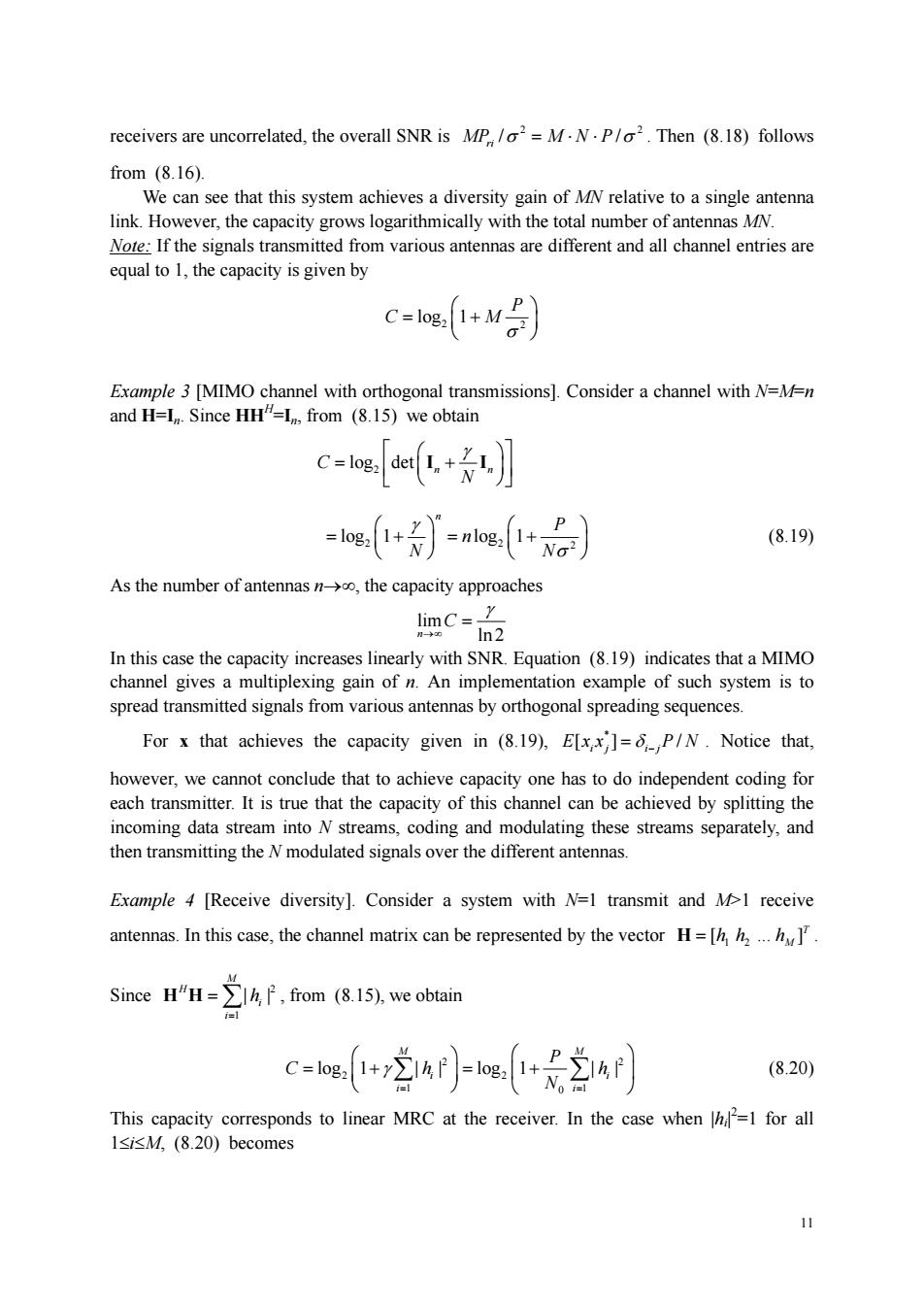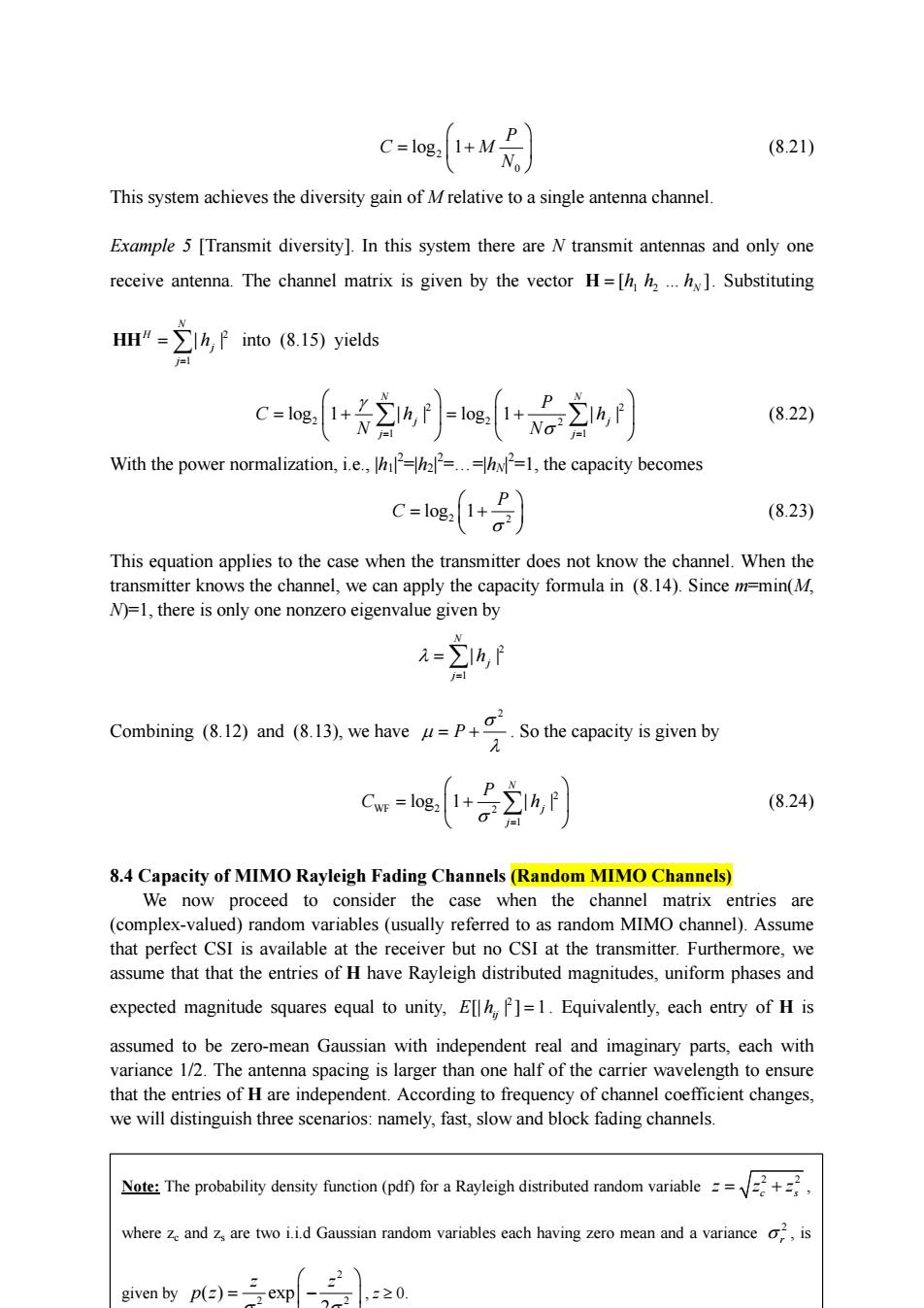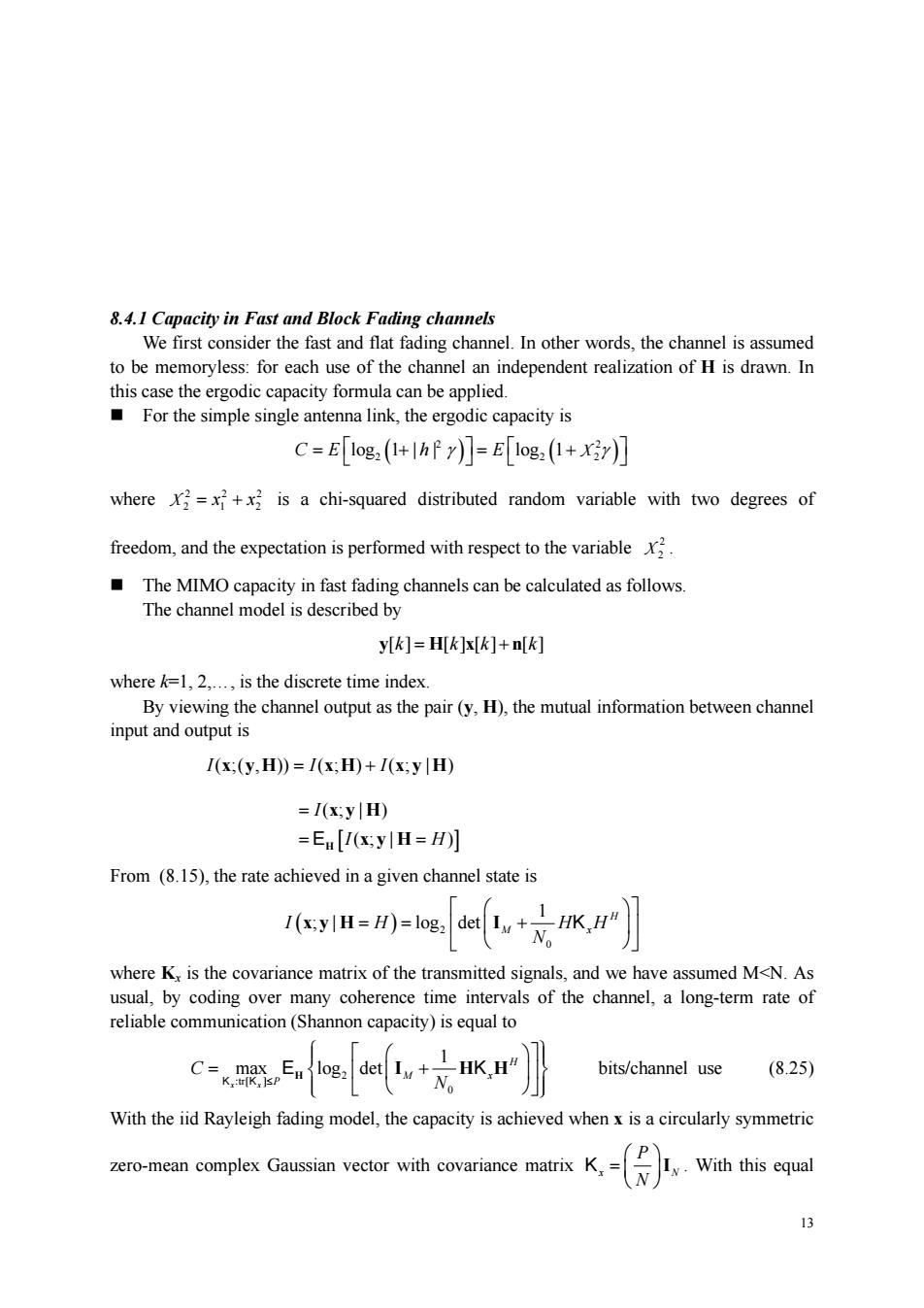
receivers are uncorrelated,the overall SNR is MP/2=M.N.P/2.Then (8.18)follows Wecan see that this system achieves a diversity gain of relative to a single antenna link.However,the capacity grows logarithmically with the total number of antennas MN. Note:If the signals transmitted from various antennas are different and all channel entries are equal to 1,the capacity is given by .) Example 3 [MIMO channel with orthogonal transmissions].Consider a channel with N=M=n and H=I.Since HH"=I.from (8.15)we obtain C=log:detI+ -los,)log.) (8.19) As the number of antennas,the capacity approaches mc=品 In this case the capacity increases linearly with SNR.Equation(819)indicates that a MIMO nel gives a ofAn implem ple of such system is to spread transmitted signals from various antennas by orthogonal spreading sequences. For x that achieves the capacity given in (8.19),E[x=P/N.Notice that, however,we cannot conclude that to achieve capacity one has to do independent coding for each transmitter.It is true that the capacity of this channel can be achieved by splitting the incoming data stream into N、 streams,coding and odulating these streams separately,and then transmitting the N modulated signals over the different antennas Example 4 [Receive diversity].Consider a system with N=l transmit and M1 receive antennas.In this case,the channel matrix can be represented by the vector H=[ SinceH"H=,from (8.15),we obtain C-lo.)0g. (8.20) This capacity corresponds to linear MRC at the receiver.In the case when1for all 1≤iM,(8.20)becomes 11
11 receivers are uncorrelated, the overall SNR is 2 2 / / MP M N P ri . Then (8.18) follows from (8.16). We can see that this system achieves a diversity gain of MN relative to a single antenna link. However, the capacity grows logarithmically with the total number of antennas MN. Note: If the signals transmitted from various antennas are different and all channel entries are equal to 1, the capacity is given by 2 2 log 1 P C M Example 3 [MIMO channel with orthogonal transmissions]. Consider a channel with N=M=n and H=In. Since HHH=In, from (8.15) we obtain 2 log det C n n N I I 2 2 2 log 1 log 1 n P n N N (8.19) As the number of antennas n, the capacity approaches limn ln 2 C In this case the capacity increases linearly with SNR. Equation (8.19) indicates that a MIMO channel gives a multiplexing gain of n. An implementation example of such system is to spread transmitted signals from various antennas by orthogonal spreading sequences. For x that achieves the capacity given in (8.19), * [] / E i j ij xx P N . Notice that, however, we cannot conclude that to achieve capacity one has to do independent coding for each transmitter. It is true that the capacity of this channel can be achieved by splitting the incoming data stream into N streams, coding and modulating these streams separately, and then transmitting the N modulated signals over the different antennas. Example 4 [Receive diversity]. Consider a system with N=1 transmit and M>1 receive antennas. In this case, the channel matrix can be represented by the vector 1 2 [ . ]T M H hh h . Since 2 1 | | M H i i h H H , from (8.15), we obtain 2 2 2 2 1 1 0 log 1 | | log 1 | | M M i i i i P Ch h N (8.20) This capacity corresponds to linear MRC at the receiver. In the case when |hi| 2 =1 for all 1iM, (8.20) becomes

c-fu别 (8.21) This system achieves the diversity gain of Mrelative to a single antenna channel. Example 5[Transmit diversity].In this system there are N transmit antennas and only one receive antenna.The channel matrix is given by the vector H=[].Substituting HH"h into (8.15)yields c=+24f小-e+石2r (8.22) N With the power normalization,i.e=1,the capacity becomes C-loe. (8.23) This equation applies to the case when the transmitter does not know the channel.When the transmitter knows the channel,we can apply the capacity formula in (8.14).Since m=min(M, N=1,there is only one nonzero eigenvalue given by =∑hf Combiang812)amd1像13),we have=P+号sote6apat的sgveny e+号2 (8.24) 8.4 Capacity of MIMO Rayleigh Fading Channels(Random MIMO Channels) We now proceed to consider the case when the channel matrix entries are Furthermore,we assume that that the entries of H have Rayleigh distributed magnitudes,uniform phases and expected magnitude squares equal to unity,E]=1.Equivalently,each entry of H is assumed to be zero-mean Gaussian with independent real and imaginary parts,each with e 1/2.The spacing s larger than one half of the ensure that the entries of H are independent.According to frequency of channel coefficient changes, we will distinguish three scenarios:namely,fast,slow and block fading channels. NoteThe probability density function (pdf)for a Rayleigh distributed random variable=+ whereandare two i.i.d Gaussian random variables each having zero mean and a variance,is ven by p()= 20
12 2 0 log 1 P C M N (8.21) This system achieves the diversity gain of M relative to a single antenna channel. Example 5 [Transmit diversity]. In this system there are N transmit antennas and only one receive antenna. The channel matrix is given by the vector 1 2 [ . ] N H hh h . Substituting 2 1 | | N H j j h HH into (8.15) yields 2 2 2 2 2 1 1 log 1 | | log 1 | | N N j j j j P Ch h N N (8.22) With the power normalization, i.e., |h1| 2 =|h2| 2 =.=|hN| 2 =1, the capacity becomes 2 2 log 1 P C (8.23) This equation applies to the case when the transmitter does not know the channel. When the transmitter knows the channel, we can apply the capacity formula in (8.14). Since m=min(M, N)=1, there is only one nonzero eigenvalue given by 2 1 | | N j j h Combining (8.12) and (8.13), we have 2 P . So the capacity is given by 2 WF 2 2 1 log 1 | | N j j P C h (8.24) 8.4 Capacity of MIMO Rayleigh Fading Channels (Random MIMO Channels) We now proceed to consider the case when the channel matrix entries are (complex-valued) random variables (usually referred to as random MIMO channel). Assume that perfect CSI is available at the receiver but no CSI at the transmitter. Furthermore, we assume that that the entries of H have Rayleigh distributed magnitudes, uniform phases and expected magnitude squares equal to unity, 2 [| | ] 1 E hij . Equivalently, each entry of H is assumed to be zero-mean Gaussian with independent real and imaginary parts, each with variance 1/2. The antenna spacing is larger than one half of the carrier wavelength to ensure that the entries of H are independent. According to frequency of channel coefficient changes, we will distinguish three scenarios: namely, fast, slow and block fading channels. Note: The probability density function (pdf) for a Rayleigh distributed random variable 2 2 c s z zz , where zc and zs are two i.i.d Gaussian random variables each having zero mean and a variance 2 r , is given by 2 2 2 ( ) exp 2 z z p z , z 0

8.4.1 Capacity in Fast and Block Fading channels We first consider the fast and flat fading channel.In other words,the channel is assumed to be memoryless:for each use of the channel an independent realization of H is drawn.In this case the ergodic capacity formula can be applied. For the simple single antenna link,the ergodic capacity is C=E log:(1+hf)=E log:(1+x3y) where=x is a chi-squared distributed random variable with two degrees of freedom,and the expectation is performed with respect to the variable The MIMO capacity in fast fading channels can be calculated as follows. The channel model is described by y]=]+n[k] where =1,2.is the discrete time index By viewing the channel output as the pair(y.H),the mutual information between channel input and output is /(x;(y,H))=/(x:H)+/(x:y|H) =/(x;y|H) =En [I(x:y=)] From (8.15),the rate achieved in a given channel state is 水n=-sa+k归rj刃 where K,is the covariance matrix of the transmitted signals,and we have assumed M<N.As usual,by coding over many coherence time intervals of the channel,a long-term rate of reliable communication(Shannon capacity)is equal to C=max Enlogz det Iw+HK,H" bits/channel use (825) With the iid Rayleigh fading model,the capacity is achieved whenx is a circularly symmetric mplex Gaussian vector with covariance matrix K.W 13
13 8.4.1 Capacity in Fast and Block Fading channels We first consider the fast and flat fading channel. In other words, the channel is assumed to be memoryless: for each use of the channel an independent realization of H is drawn. In this case the ergodic capacity formula can be applied. For the simple single antenna link, the ergodic capacity is 2 2 2 22 CE h E log 1 | | log 1 X where 2 22 212 X x x is a chi-squared distributed random variable with two degrees of freedom, and the expectation is performed with respect to the variable 2 X 2 . The MIMO capacity in fast fading channels can be calculated as follows. The channel model is described by y[] [][] [] k kk k Hx n where k=1, 2,., is the discrete time index. By viewing the channel output as the pair (y, H), the mutual information between channel input and output is I II ( ;( , )) ( ; ) ( ; | ) x y H xH x y H (; | ) (; | ) I I H H x y H E xy H From (8.15), the rate achieved in a given channel state is 2 0 1 ; | log det H M x I H HH N xy H I K where Kx is the covariance matrix of the transmitted signals, and we have assumed M<N. As usual, by coding over many coherence time intervals of the channel, a long-term rate of reliable communication (Shannon capacity) is equal to 2 :tr[ ] 0 1 max log det x x H M x P C N H I HH K K E K bits/channel use (8.25) With the iid Rayleigh fading model, the capacity is achieved when x is a circularly symmetric zero-mean complex Gaussian vector with covariance matrix x N P N K I . With this equal